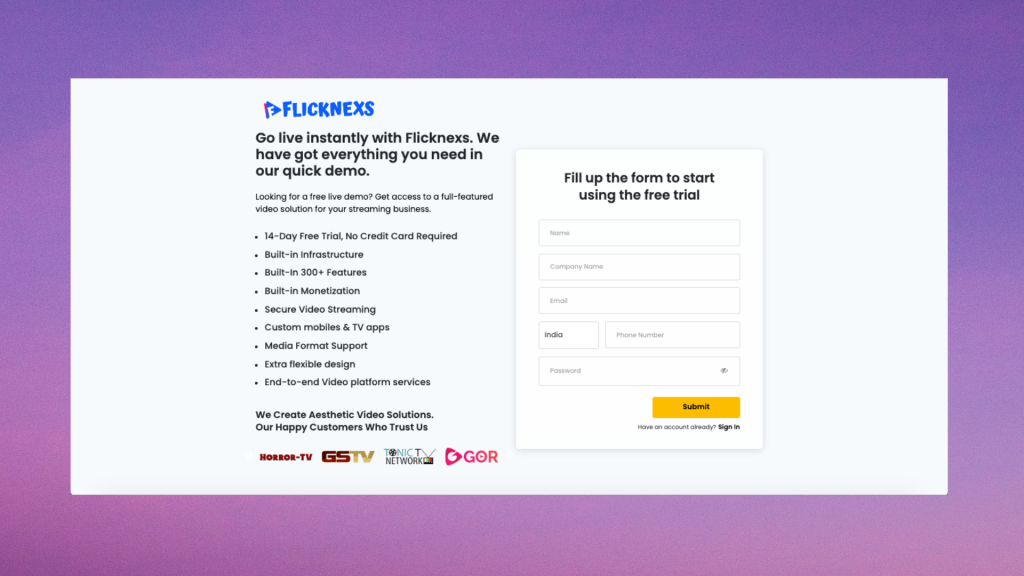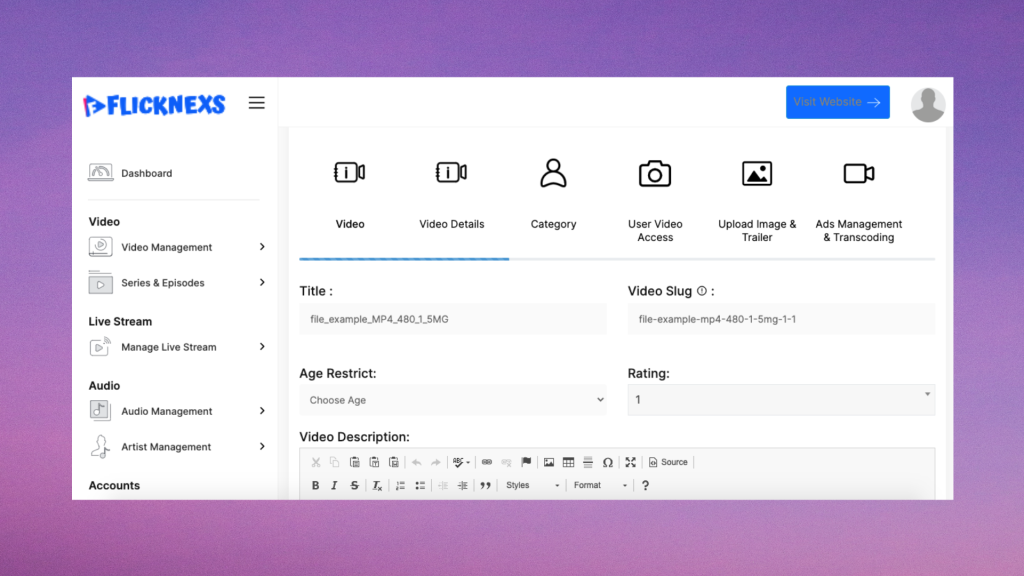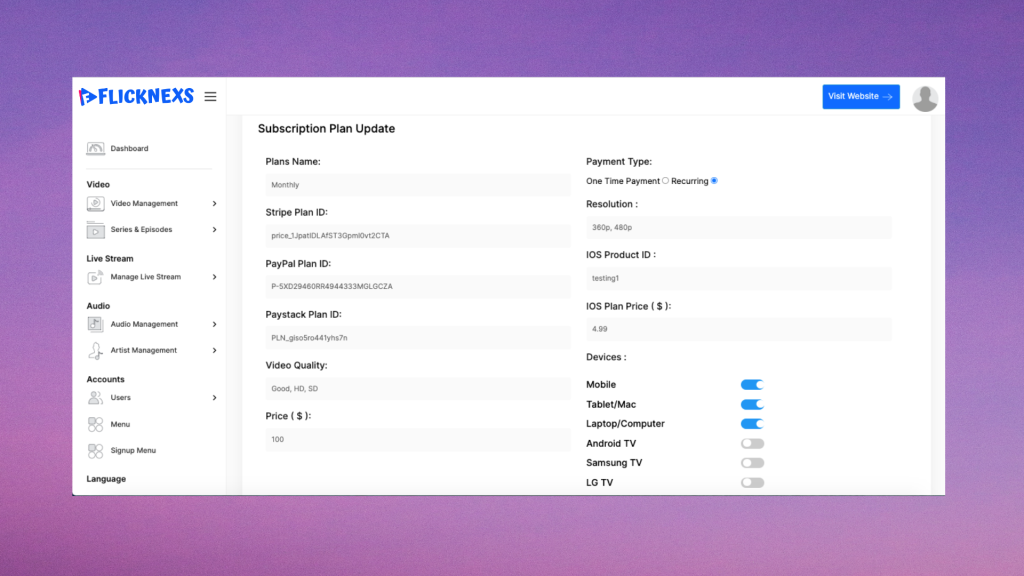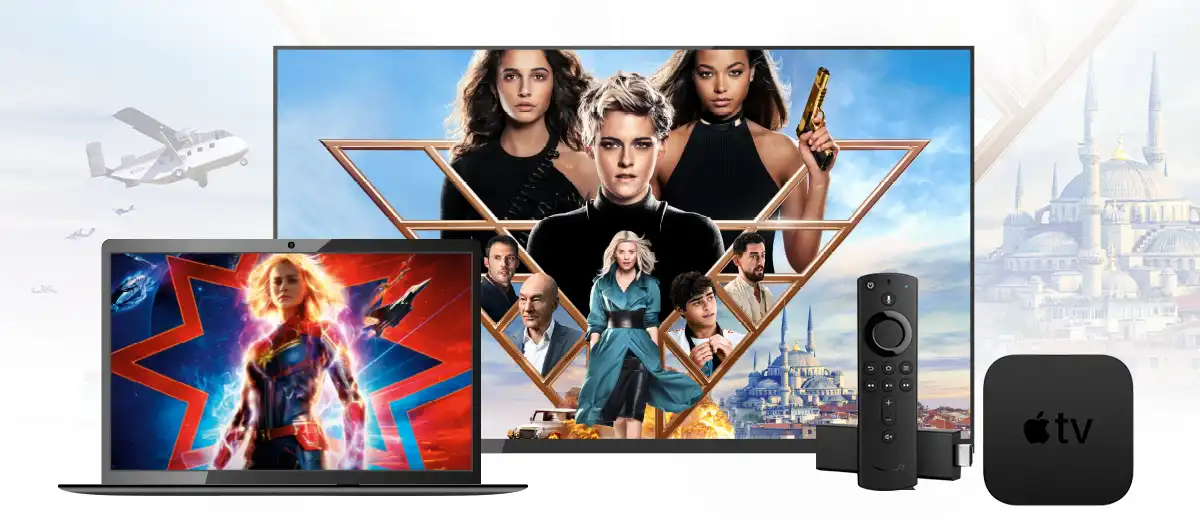SVOD (Subscription Video on Demand) is transforming how people watch content online, offering viewers unlimited access to movies, TV shows, and exclusive videos for a recurring subscription fee.
As one of the fastest-growing OTT monetization models, SVOD has revolutionized digital entertainment by delivering convenience, personalization, and value to millions of subscribers worldwide.
In this beginner-friendly guide, we’ll break down what SVOD means, how it works, its key features and benefits, how it compares with other monetization methods like AVOD and TVOD, and why it plays a crucial role in the future of streaming platforms.
What is SVOD?
Subscription Video on Demand is a method of generating revenue by offering viewers access to your complete content library through a monthly or yearly subscription fee. These subscriptions are typically auto-renewed and provide payment on a regular basis for your entire collection of audio or video content.
What Are the Latest Trends and Statistics in SVOD?
SVOD (Subscription Video on Demand) is a type of video streaming service where users pay a monthly or yearly subscription fee to access a library of content. SVOD has become increasingly popular in recent years as more people choose to cut the cord with traditional cable and satellite TV providers.
According to statistics from Statista, the global SVOD market is projected to grow from $62.3 billion in 2020 to $86.8 billion in 2026. North America is currently the largest SVOD market, accounting for approximately 43% of global SVOD revenues in 2020. However, the Asia-Pacific region is expected to experience the fastest growth in the coming years.
Netflix is currently the leading SVOD provider, with over 200 million subscribers worldwide as of April 2021. Other major players in the market include Amazon Prime Video, Disney+, HBO Max, and Hulu.
One trend in the SVOD market is the increasing production of original content by providers. Netflix invests significantly in producing original content to stand out and retain subscribers. Bundling SVOD services with other products or services, like mobile phone plans or internet packages, is another emerging trend.
Overall, the market is expected to continue growing as more people choose to consume entertainment content through streaming services.
Read More About: How OTT Technology Is Shaping The Future Of Entertainment
Can SVOD services replace traditional cable television?
The cord-cutting trend is rapidly gaining momentum globally, as evidenced by the statistics. In the United States, it is anticipated that a significant portion of Americans, approximately one in every three individuals, will choose to discontinue their cable TV subscriptions in 2023.
This shift can be attributed to several factors contributing to the rise of SVOD platforms:
Abundance of captivating content on SVOD services
SVOD platforms offer a wide array of high-quality content, including movies, TV shows, documentaries, and original productions, enticing viewers with a diverse range of options.
Cost-effectiveness of subscription plans
SVOD services typically offer affordable subscription plans, allowing viewers to access a vast library of content at a fraction of the cost of cable TV subscriptions.
Impressive internet speeds
The availability of blazing-fast internet connections enables smooth streaming of content on SVOD platforms, ensuring an uninterrupted and enjoyable viewing experience.
Growing prevalence of smart TVs and smartphones
The increasing adoption of smart TVs and smartphones among consumers has made it more convenient to access SVOD apps. Major smart TV operating systems such as webOS (LG TV) and Tizen OS (Samsung) come preloaded with a variety of SVOD OTT apps, and users can easily download additional ones, granting them easy access to their favorite content on their televisions.
The numbers speak for themselves, as approximately 85% of US households now subscribe to at least one SVOD service, surpassing the cable TV penetration rate significantly.
While SVOD subscriptions continue to surge at an astonishing rate and cable TV’s market share declines, it is unlikely that SVOD will completely replace cable TV in the near future. Cable TV still holds a considerable portion of the market as a prominent legacy option for consuming video and TV content.
What Are the Key Advantages and Disadvantages of SVOD?
| Advantages | Disadvantages |
| Access to a wide variety of content, including exclusive and original programming. | Requires a stable and fast internet connection. |
| Can be more affordable than traditional cable or satellite TV packages. | Subscription fees can add up quickly if multiple services are used. |
| Offers the ability to watch content on demand, allowing for greater flexibility and convenience. | Limited access to live programming such as news and sports. |
| Allows for multiple users to access the same account and watch content simultaneously. | Content libraries can vary by region, limiting access to certain shows and movies. |
| Offers the ability to watch on a variety of devices, including TVs, computers, and mobile devices. | Quality of content can vary, with some offerings being lower quality or poorly produced at times |
| Provides recommendations based on viewing history, making it easier to discover new content. | May not offer all the same features as traditional TV, such as DVR or parental controls. |
| No commercials or advertisements interrupting viewing experience. | Requires a subscription to access content, which may not be feasible for everyone. |
Overall, It offers many benefits such as convenience, flexibility, and affordability. However, it also has some limitations, such as the need for a stable internet connection and the cost of multiple subscriptions. It’s important to weigh the advantages and disadvantages before deciding whether SVOD is the right choice for your entertainment needs.
Read Also This : SVOD vs AVOD: Comparing the Two Video Monetization Model In Detail
How Is SVOD Different From Other Monetization Models?
Subscription-based platforms possess a distinct advantage compared to other revenue models, as they exhibit strategic profitability and offer valuable support to OTT services in sustaining their presence in the industry with minimal disruptions.
| Factors | SVOD (Subscription Video on Demand) | AVOD (Ad-Supported Video on Demand) | TVOD (Transactional Video on Demand) |
| Revenue Generation Style | Small recurring fee based on monthly/yearly plans | Payment from advertisers depending on views | Income through buy/rent option |
| Content Access | Unlimited access to entire catalog of content | Limited access to free content | Pay-per-view basis |
| Duration of Access | As long as the subscription is paid | As long as the user prefers | Limited window of 24/48 hrs for rented videos<br>Forever access for videos that are purchased |
| Ads | Ad-free experience | Ads may be included | Ads may be included |
| Market Players | Netflix, Hulu, Amazon Prime Video, Disney+, HBO Max | YouTube, Crackle, Pluto TV | Apple iTunes, Google Play |
| Suitable for | Solutions with extensive content libraries | Solutions with a large audience base | Solutions offering premium/exclusive/seasonal content |
Is SVOD the right model for You?
Whether or not SVOD (Subscription Video on Demand) is the right model for you depends on your personal preferences and viewing habits. Here are some factors to consider:
Content Preferences
SVOD services offer a wide variety of content, including TV shows, movies, and original programming. If you prefer having access to a large library of content and enjoy binge-watching, then SVOD might be the right choice for you.
Cost
While SVOD can be more affordable than traditional cable or satellite TV packages, it does require a monthly or yearly subscription fee. If you’re on a tight budget or only watch a few shows, then paying for individual episodes or renting movies might be a better option.
Internet Connection
A stable and fast internet connection is necessary to stream content through SVOD services. If you have a slow or unreliable internet connection, then you may experience buffering or other issues that could affect your viewing experience.
Live Programming
If you enjoy watching live programming such as sports or news, then SVOD may not be the best choice for you. While some services offer live TV options, they are limited and may not have all the same features as traditional cable or satellite TV packages.
Device Compatibility
SVOD services can be accessed on a variety of devices, including TVs, computers, and mobile devices. If you prefer watching content on a specific device or have multiple devices you use for viewing, then SVOD could be a good fit for you.
Overall, SVOD is ideal for on-demand viewing, diverse content preferences, and stable internet connections. However, it may not suit those who enjoy live programming or have limited funds for monthly subscriptions. Consider personal preferences and viewing habits to decide if SVOD is the right fit.
Explore More: 5 Simple Steps to Create Your Own OTT Platform
Why Subscription Video-On-Demand is the Best Option to Make Money?
Streaming giants such as Netflix, Amazon Prime, Hulu, and Disney+ have a strong preference for SVOD services, as they continue to dominate the market and show promising growth in the coming years.
Projections indicate that an astounding 568 million individuals will engage in video streaming through these platforms by the year 2022. Among the various types of video streaming, SVOD stands out as the largest segment, with a market volume of USD 71,237 million in 2021. Impressively, Statista predicts this figure to surge beyond USD 108,306 million within the next five years.
As for the average income per person in the Video-on-Demand realm, analysts anticipate it to reach a noteworthy USD 47.86 in 2021. Furthermore, the Video-on-Demand segment is poised to experience substantial user growth, with an estimated 2,218.2 million users anticipated by the year 2025.
When Can a Streaming Platform Generate Revenue with SVOD?
There are no set guidelines for monetizing a streaming business, especially with SVOD. Over-the-top (OTT) technology is relatively new, and successful market players have often experimented with their business models before establishing revenue streams. Here are some factors to consider when deciding to adopt SVOD:
Extensive Content Library: Having a substantial collection of content is advantageous.
Niche Market Focus: A specialized model catering to a specific audience can be beneficial.
Investment in Original/Exclusive Content: Allocating resources to create unique content periodically can attract viewers.
Subscriber Acquisition and Retention: Being prepared to invest in acquiring new subscribers and retaining existing ones is crucial.
Free Trial Offer: Providing a free trial can help entice viewers to try your service.
Viewer Behavior Analysis: Continuously analyzing viewer preferences and adjusting content accordingly is important.
Flexible Plans: Offering flexible subscription plans can accommodate varying user preferences.
Recurring Passive Income: Seeking a reliable and consistent revenue stream is a key consideration.
How to get started with SVOD by Flicknexs
Sign up for Flicknexs

Visit the Flicknexs website and sign up for an account. You will need to choose a pricing plan that fits your needs and budget.
Set up your account
Once you’ve signed up, you’ll need to set up your account by creating a profile and selecting the content you want to offer on your SVOD platform.
Customize your platform
Flicknexs allows you to customize your SVOD platform with your branding, logo, and colors. You can also create a custom domain name for your platform.
Add content

After setting up your account and customizing your platform, you can start adding content. Flicknexs allows you to upload videos in a variety of formats and offers tools for organizing your content.
Set up payment processing

Flicknexs provides multiple payment processing options, including credit card and PayPal. You can set up your payment options and choose pricing plans for your content.
Launch your platform
Once you’ve added content and set up payment processing, you’re ready to launch your SVOD platform. Flicknexs provides tools for promoting your platform and tracking analytics.
Overall, getting started with SVOD by Flicknexs is a straightforward process that involves setting up your account, customizing your platform, adding content, and setting up payment processing. With the right content and promotion, you can build a successful SVOD platform that attracts and retains subscribers.
Conclusion
SVOD is an online video streaming service that offers a wide range of movies, TV shows, and content through subscriptions. Platforms like Netflix, Amazon Prime Video, and Hulu have transformed entertainment consumption, providing convenient and affordable access from anywhere. Beginners should grasp the features, benefits, subscriptions, content libraries, and interfaces to make informed choices based on interests, budget, and viewing habits.



Leave a Reply